► We visit the Toyota Collection at TGR-E
► Based in Cologne and also home to WEC and Rally programs
► Former home to the F1 program
Toyota’s association with motorsport has always been rich and varied, if not fragmented. Stints in rallying, F1 and prototype racing have all helped lay the groundwork that forms the DNA of wilder cars such as the GR86, GR Yaris and the Supra – and even distant relatives like the Lexus LFA. If you want to see this story in one place, there’s nowhere better than the Toyota Collection in Cologne.
Crammed under one of two still used wind tunnels, the Toyota Collection is nestled in the bowels of Toyota Gazoo Racing Europe, home of the brand’s WEC and Rallying programs. Originally founded in 1979 as Andersson Motorsport by Toyota rally driver Ove Andersson, the company eventually moved to Cologne due to its proximity to the road car office and Brussels. There it became a base for Toyota Team Europe, and later a sprawling facility and de-facto HQ for almost all things Toyota racing.

We’ve arranged a tour to see the Collection, but first we wait in the reception while someone has their phone stickered by the receptionist. It’s a reminder that this is still a cutting-edge, active factory with sensitive information in places – it just happens to have a museum in the middle.
Once we’re in, the sheer scale of the facility becomes evident. There are two wind tunnels here, one 60% (the smallest size with real life correlation) and one full-size, both employed by Toyota, several undisclosed MotoGP teams and, until recently, McLaren (although Woking’s new one is now operational). There’s also a state-of-the-art sim rig too, used by the endurance drivers to test setups, and familiarise themselves with circuits between races.
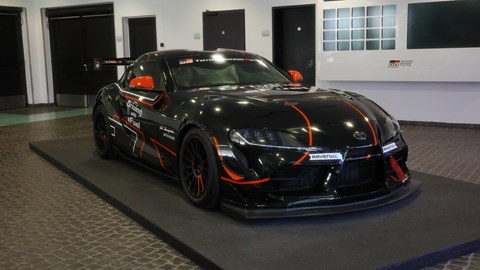
Most of the facilities here are a product of F1 days. Toyota pumped a reported £450m in 2008 alone into its F1 project and employed up to 1200 people at its height. Fast-forward to 2024 and the three cars in the lobby represent Cologne’s key projects now. Its WEC chassis is made here (the engine in Japan), the rally cars are assembled here (the team is run from Finland), and customer race cars such as the Supra GT4 are produced here too. That sounds like a lot, but the factory is manned by just 450 staff – a skeleton crew compared to the F1 days.
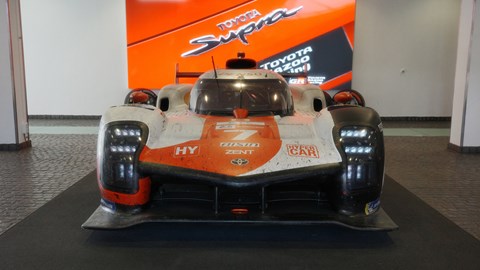
After the lobby, there are just a few corridors to go through, and our guide Yannick takes us past a hall with the racing overalls of Andersson, the site’s founder. Our guide is from Cologne originally and joined here after an apprenticeship; he explains that it’s a fiercely competitive but attractive route into motorsport for those in the area. He also tells us Andersson was a huge rallying fan himself, and a big part of Toyota’s motorsport vision in Europe; right up until his 2008 death in a rallying accident.
The Collection
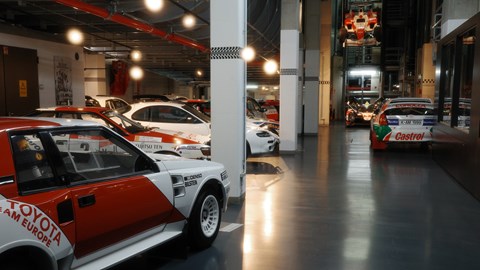
There’s something unofficial and secretive about the Toyota Collection. We walk through another corridor; Yannick swipes his pass and, as the floor to ceiling factory doors open, it feels as though we’re somewhere we shouldn’t be. This isn’t a museum, but a place Toyota stores its old racing machines – just under the tools it uses to create its current ones.
There are no real info panels nor glass boxes around these exhibits, and it feels as though this space is Toyota Motorsport’s equivalent of the awkward spare room with the boiler in it. Above the cars, gleaming networks of pipes and wires snake up and down, some swooping below head height.
Meeting the GT-One in person
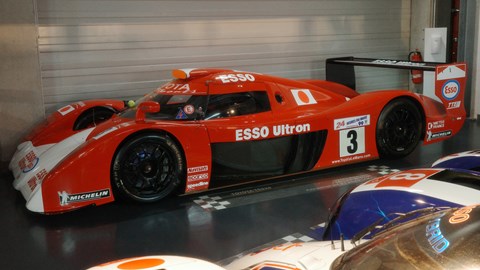
For a diehard video game fan like myself, this is Gran Turismo made real – a shrine to the hours I spent bombing around 128-bit tracks on the PS2. And the main reason for this pilgrimage? The two Toyota GT-One cars I spot in the furthermost corner. Both the ‘98 and ‘99 cars are here, and both achieved mythical status for me and many other gamers.
Known as a game-breaker for the sheer grunt it could produce on the PlayStation, (when tuned within an inch of its life) the GT-One’s scary power, alien-like streamlined body and classic looks left an indelible mark on my childhood. In person, it’s only more striking.
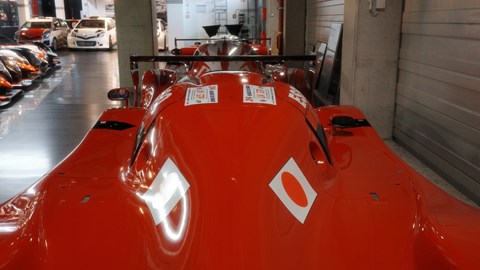
Next to the newer more aero-capable and significantly more successful prototypes, it now looks elegant rather than dated; its curves draped over the chassis like someone’s thrown a silk sheet over it. It’s not shrink-wrapped, like modern WEC cars but looks all the better for it. It’s sweeping lines aren’t really ruined by winglets or vortex generators either; even the 90-degree V8’s pipes poke out just under the bodywork alongside some primitive looking rear lights. Nothing screams race car more. I’m all for progress, but this looks special.
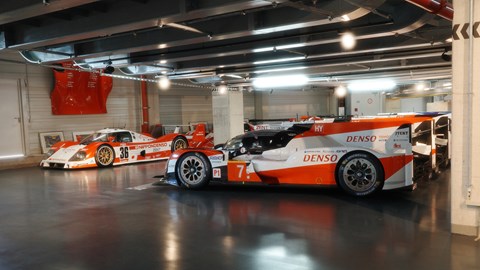
In competition, this car never scaled the heights of the GR010 nor the TS050 that sits just a few feet away. The GT-One achieved just two podiums in its two-year run, and Toyota’s latest stint in endurance racing (announced in 2012 to make use of more of the F1 facilities) has been considerably more successful. The TS050 has three straight Le Mans victories while the GR010 has won just once at Le Mans, but has bagged three straight drivers’ and constructors’ championships.
Yannick tells me the street version of the GT-One is usually here too; a reminder that this is one of the last Le Mans cars that required homologation to race. It’s bordering on a classic now, but only feels old once we open the door and see the relatively low-tech cockpit.

Pictures and videos taken, it’s time to move to the second reason to be here; a look at the brand’s F1 program. Cars from before and after the team’s official time in F1 are all lined up in a particularly low part of the space, starting with a blocky TF101 test mule from 2001 and extending all the way to a sleek, never raced Toyota TF110 – finished in carbon fibre. It’s one of two chassis produced for the 2010 season, and it’s acting as a monument to the team’s sudden withdrawal from the sport at the end of 2009.
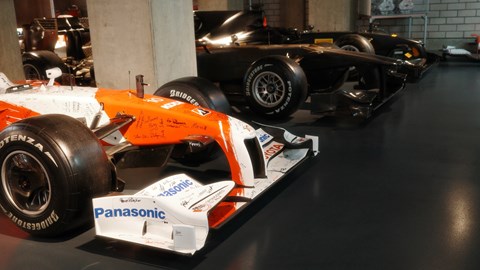
It’s the most extreme case of ‘what might have been’ at the facility – although this theme screams loudly throughout my tour. Toyota has no wins and just thirteen podiums to show for its eight-year stint in F1, despite the astronomical budget. The week of my visit, nebulous rumours suggest the Haas team will employ Toyota to help with its F1 program in 2026 and beyond – with a possible view for the brand to return as an OEM later on. Let’s hope so.
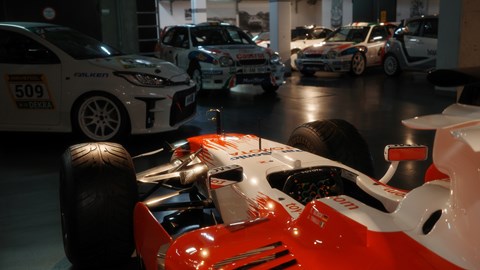
Toyota’s rallying history is represented here too, including a championship-winning Carlos Sainz Sr Corolla from 1999, a 1991 Sainz-driven Celica ST165 and Celica TA64 among others. Just like the F1 and endurance cars, there’s a strong technological progression as new move through the years – though there’s a purity to the older models. Still, modern rallying is captivating in its own way.
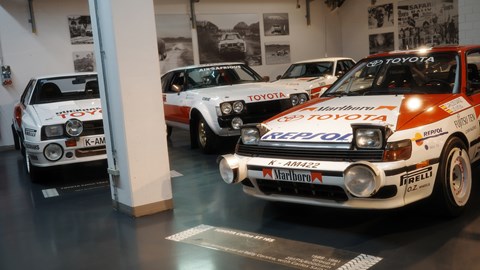
A sensible amount of time has passed, and it’s time to stop poring over the collection. I could have been there for hours, though. As I leave, I’m once again reminded of the original purpose of the place: the 60% wind tunnel fires up momentarily, and I’m told by our guide that it used to run almost 24 hours a day, with teams of technicians working in shifts. As you’d expect, Yannick isn’t allowed to tell me what it’s being used for right now.

See it yourself
The Toyota Collection feels like an intimate storage facility, nestled in the bowels of an active racing team – and that’s because it is – but, incredibly, it’s open to the public. If you’re a fan of motorsport or Gran Turismo, it’s worth a visit alone due to the rarity of some of the stuff on show – and the fact you get to have a cursory look around an active race team’s factory too. Throw in an imposing gothic cathedral and a few glasses of Kölsch in the city centre, and it’s a no-brainer.
For more details you can visit Toyota’s website here.